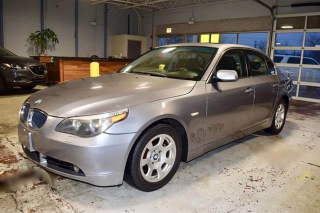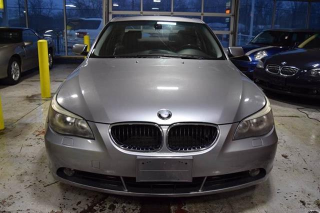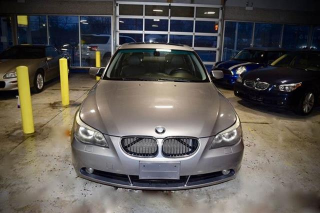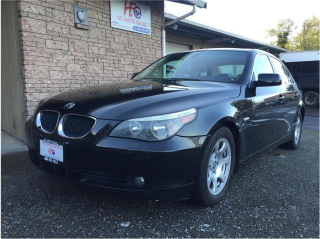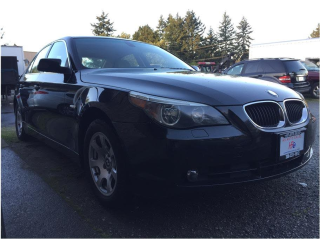The 2004 BMW 5-Series (E60) represents the fifth generation of BMW's executive car, known for its blend of sportiness and luxury. It's a four-door sedan with model years spanning from 2003 to 2010. Key trims include the 525i, 530i, 545i, and the high-performance M5. When new, pricing ranged from around $40,000 to $70,000+. Its sharper styling, advanced technology, and engaging driving dynamics made it a popular choice in its class.
The Good
The 2004 BMW 5-Series offers a compelling blend of performance and luxury. Its responsive engines and balanced handling provide an engaging driving experience. The comfortable interior and refined design appeal to emotional buyers, while practical advantages include decent fuel efficiency for its class and a reputation (though somewhat debated) for solid engineering and resale value.
The Bad
The 2004 BMW 5-Series has known weaknesses, primarily centered around its electrical systems and some engine components. Watch out for issues with the iDrive system, sensor failures, oil leaks (especially valve cover and oil pan), and cooling system problems. Maintenance can be expensive, and some repairs require specialized knowledge.
2004 BMW 5-Series: Quick Overview
- Engine Options:
- 525i: 2.5L Inline-6 (M54)
- 530i: 3.0L Inline-6 (M54)
- 545i: 4.4L V8 (N62)
- Horsepower:
- 525i: 184 hp
- 530i: 225 hp
- 545i: 325 hp
- Fuel Economy (EPA Estimated):
- 525i: 20 mpg city / 29 mpg highway (may vary)
- 530i: 19 mpg city / 28 mpg highway (may vary)
- 545i: 16 mpg city / 24 mpg highway (may vary)
- 0-60 Times:
- 525i: Approximately 7.9 seconds
- 530i: Approximately 6.8 seconds
- 545i: Approximately 5.8 seconds
- Towing Capacity: Not generally recommended or advertised for the 5-Series.
- Trim Level Features:
- 525i: Standard features include automatic climate control, power front seats, premium sound system, leatherette upholstery, and alloy wheels.
- 530i: Adds to the 525i with features like upgraded interior trim, premium leather options, and potentially sportier suspension tuning.
- 545i: Includes all the features of the lower trims plus a more powerful V8 engine, larger brakes, sport suspension (often), and more luxurious interior appointments, such as upgraded leather and wood trim.
- Common Options: Sport Package (sport seats, sport suspension, upgraded wheels), Premium Package (leather upholstery, sunroof), Cold Weather Package (heated seats, headlight washers), Navigation System (iDrive), and upgraded audio systems.
2004 BMW 5-Series Specifications
Vehicle Information
| Year | 2004 |
| Make | BMW |
| Model | 5-Series |
| Trim | - |
| Style | 6-Speed Manual |
| Type | Sedan |
| Category | Compact Car |
Manufacturing Details
| Made In | Germany |
| Manufacturing City | DINGOLFING |
Dimensions
| Doors | 4-Door |
| Curb Weight | 1579.86 kg |
| Gross Vehicle Weight Rating | - |
| Overall Height | 147.32 cm |
| Overall Length | 484.12 cm |
| Overall Width | 184.66 cm |
| Wheelbase Length | 288.8 cm |
| Standard Seating | 5 |
Engine & Performance
| Engine | 3.0-L L-6 DOHC 24V |
| Engine Size | 3L |
| Engine Cylinders | 6 |
| Transmission | 6-Speed Manual |
| Transmission Type | Manual |
| Transmission Speeds | 6-Speed |
| Drivetrain | Rear-Wheel Drive |
Additional Features
| Anti-Brake System | 4-Wheel ABS |
| Steering Type | Rack & Pinion |
Pricing
| Manufacturer Suggested Retail Price (MSRP) | $44,900 USD |
| Invoice Price | $41,020 USD |
| Delivery Charges | $695 USD |
Vehicle History Report
Vehicle
Specifications
Specifications
Ownership
History
History
All History
Events
Events
NMVTIS Title
History Check
History Check
Salvage/Rebuilt
Check
Check
Accident
Check
Check
Theft
Check
Check
Open Lien
Check
Check
Past Sale
Listings
Listings
Safety
Recalls
Recalls
Odometer
Check
Check
Market Price
Analysis
Analysis
What Problems Does the 2004 BMW 5-Series Have?
The 2004 BMW 5-Series (E60) is known for several frequently reported problems. Electrical issues are common, particularly related to the iDrive system, which can experience glitches or complete failures. Sensor failures, including oxygen sensors and mass airflow sensors, are also frequent and can lead to poor engine performance. Oil leaks, especially from the valve cover gasket and oil pan gasket, are a recurring concern. Cooling system problems, such as radiator leaks and thermostat failures, can lead to overheating if not addressed promptly.
Recalls for the 2004 model year included issues related to fuel pump malfunctions and potential battery cable connection problems. Long-term reliability concerns often revolve around the complex electronic systems, which can become increasingly prone to failures as the car ages. The automatic transmission can also develop issues over time, requiring costly repairs or replacement. Models with the V8 engine (545i) may experience timing chain issues, which can be a significant expense to repair. Preventative maintenance and careful monitoring of fluid levels are crucial for mitigating these potential problems. Owners should also be aware of potential issues with the adaptive headlights (if equipped) and the sunroof mechanism.
Recalls for the 2004 model year included issues related to fuel pump malfunctions and potential battery cable connection problems. Long-term reliability concerns often revolve around the complex electronic systems, which can become increasingly prone to failures as the car ages. The automatic transmission can also develop issues over time, requiring costly repairs or replacement. Models with the V8 engine (545i) may experience timing chain issues, which can be a significant expense to repair. Preventative maintenance and careful monitoring of fluid levels are crucial for mitigating these potential problems. Owners should also be aware of potential issues with the adaptive headlights (if equipped) and the sunroof mechanism.
How long will the 2004 BMW 5-Series last?
A well-maintained 2004 BMW 5-Series can easily exceed 200,000 miles or provide 15+ years of service. However, longevity heavily depends on consistent maintenance. Neglecting repairs or skipping scheduled services will significantly shorten its lifespan. Long-term durability is generally good for the engine and transmission with proper care, but the electrical systems and plastic components are known weaknesses. Expect to address issues like sensor failures, oil leaks, and cooling system problems as the car ages. Rust can also become a concern in colder climates with salted roads, particularly around the wheel wells and undercarriage.
What Technology & Safety Features are Included?
The 2004 BMW 5-Series boasted advanced technology for its time. Standard features included automatic climate control, a premium sound system, and power-adjustable seats. The centerpiece was the iDrive system, which controlled many of the vehicle's functions through a central display screen and rotary dial. While innovative, the early iDrive system could be complex and less intuitive than modern infotainment systems.
Entertainment options included a CD player and available satellite radio. Driver-assistance features were relatively limited compared to today's standards, but included features like dynamic stability control (DSC) and anti-lock brakes (ABS). Optional features included a navigation system integrated with iDrive, park distance control (parking sensors), and adaptive cruise control. Safety features comprised multiple airbags (front, side, and curtain), and a robust chassis design.
Crash-test ratings from the Insurance Institute for Highway Safety (IIHS) and the National Highway Traffic Safety Administration (NHTSA) were generally favorable for the 2004 5-Series. The IIHS gave it a "Good" rating in frontal offset crash tests, and the NHTSA awarded it four or five stars in various crash tests, depending on the specific test and seating position. These ratings indicate a strong level of occupant protection for its era. Keep in mind that safety technology has significantly advanced since 2004.
Entertainment options included a CD player and available satellite radio. Driver-assistance features were relatively limited compared to today's standards, but included features like dynamic stability control (DSC) and anti-lock brakes (ABS). Optional features included a navigation system integrated with iDrive, park distance control (parking sensors), and adaptive cruise control. Safety features comprised multiple airbags (front, side, and curtain), and a robust chassis design.
Crash-test ratings from the Insurance Institute for Highway Safety (IIHS) and the National Highway Traffic Safety Administration (NHTSA) were generally favorable for the 2004 5-Series. The IIHS gave it a "Good" rating in frontal offset crash tests, and the NHTSA awarded it four or five stars in various crash tests, depending on the specific test and seating position. These ratings indicate a strong level of occupant protection for its era. Keep in mind that safety technology has significantly advanced since 2004.
What Colors Options are Available?
Exterior Colors
Black Sapphire Metallic
Silver Gray Metallic
Titanium Silver Metallic
Orient Blue Metallic
Alpine White
Oxford Green Metallic
Deep Green Metallic
Tasman Green Metallic
Imola Red
Champagne Quartz Metallic
Interior Colors
Sand Beige
Black
Gray
Natural Brown
2004 BMW 5-Series Prices and Market Value
When new, the 2004 BMW 5-Series ranged from approximately $40,000 for a base 525i to upwards of $70,000 for a fully equipped 545i. Current used market prices vary widely based on condition, mileage, and trim level. Expect to find examples ranging from $3,000 to $10,000, with lower mileage, well-maintained examples commanding a premium. Depreciation has been significant, as expected for a luxury vehicle of this age. Factors affecting resale value include overall condition, service history, наличие desirable options (like the Sport Package or Navigation), and geographic location. Models with extensive deferred maintenance will be worth considerably less.
2004 BMW 5-Series Cost of Ownership
The 2004 BMW 5-Series is generally considered costly to own. Insurance rates are higher than average due to its luxury status and repair costs. Fuel economy is decent but requires premium gasoline. Maintenance and repair costs can be substantial, especially for DIYers who aren't familiar with BMWs. Parts can be expensive, and labor rates are often higher at specialized BMW repair shops. Long-term ownership requires a proactive approach to maintenance to prevent major issues. Expect to spend significantly more on upkeep compared to a non-luxury vehicle.
2004 BMW 5-Series Fuel Efficiency
Fuel Type
Gasoline
Fuel Capacity
70.03 liters
City Mileage
8.08 km/l
Highway Mileage
12.33 km/l
2004 BMW 5-Series Safety Rating
NHTSA
IIHS
2004 BMW 5-Series Warranty
Basic
Original warranty
48 months / 50,000 miles
Estimated remaining
Expired
Powertrain
Original warranty
48 months / 50,000 miles
Estimated remaining
Expired
Rust
Original warranty
72 months / unlimited miles
Estimated remaining
Expired
2004 BMW 5-Series Insurance
Insurance for a 2004 BMW 5-Series is moderately priced, reflecting its status as a Sedan with strong safety ratings and
reasonable repair costs.
reasonable repair costs.
How Does the 2004 BMW 5-Series Compare to Other Sedan?
The 2004 BMW 5-Series competed against rivals like the Mercedes-Benz E-Class (W211), Audi A6 (C6), and Lexus GS. In terms of performance, the BMW offered a sportier driving experience than the Mercedes, with sharper handling and more responsive engines. The Audi A6 provided a similar level of performance with the added benefit of available quattro all-wheel drive. The Lexus GS, while not as dynamically engaging, offered superior reliability.
Features were comparable across these models, with each offering a range of luxury amenities and technology options. However, the early iDrive system in the BMW was often criticized for its complexity compared to the Mercedes' COMAND system or the Lexus' simpler interface. Reliability is where the BMW falls short compared to the Lexus GS, which consistently ranks higher in reliability surveys. The Mercedes E-Class also has its share of potential issues, though perhaps fewer than the BMW.
In terms of used prices, the 2004 5-Series is generally comparable to its rivals. If reliability is a primary concern, the Lexus GS is a better alternative. If you prefer a more comfortable ride and luxurious interior, the Mercedes-Benz E-Class might be a better fit. For those seeking a balance of performance and luxury with available all-wheel drive, the Audi A6 is a strong contender.
Features were comparable across these models, with each offering a range of luxury amenities and technology options. However, the early iDrive system in the BMW was often criticized for its complexity compared to the Mercedes' COMAND system or the Lexus' simpler interface. Reliability is where the BMW falls short compared to the Lexus GS, which consistently ranks higher in reliability surveys. The Mercedes E-Class also has its share of potential issues, though perhaps fewer than the BMW.
In terms of used prices, the 2004 5-Series is generally comparable to its rivals. If reliability is a primary concern, the Lexus GS is a better alternative. If you prefer a more comfortable ride and luxurious interior, the Mercedes-Benz E-Class might be a better fit. For those seeking a balance of performance and luxury with available all-wheel drive, the Audi A6 is a strong contender.
Final Verdict: Is the 2004 BMW 5-Series a Good Sedan?
The 2004 BMW 5-Series is ideal for enthusiasts who appreciate a sporty driving experience and are willing to accept potentially higher maintenance costs. It's worth buying *used* if you find a well-maintained example with a comprehensive service history and have a trusted mechanic familiar with BMWs. Opting for a lower-mileage 530i might be a good balance of performance and reliability compared to the more complex 545i. Thoroughly inspect any potential purchase for common issues like oil leaks, electrical problems, and cooling system concerns. If you prioritize reliability above all else, other alternatives might be more suitable. Ultimately, the decision hinges on your budget, mechanical aptitude, and tolerance for potential repairs.
